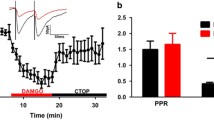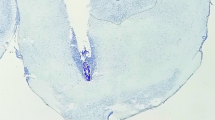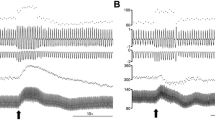Abstract
Arterial hypertension induced by microinjections of N-methyl-d-aspartate (NMDA) (2 nmol/rat) into the midbrain periaqueductal gray matter was used to assess the involvement of opioid receptors (µ, δ and κ) in modulating pressor periaqueductal gray neurons. Groups (n = 5 – 8) of urethane-anaesthetised rats received, 5 min before NMDA, microinjections of selective opioid receptor antagonists in the periaqueductal gray area and arterial blood pressure was monitored. Pretreatments with naloxone (5 nmol/rat), a non selective ,µ receptor antagonist, or naltrindole hydrochloride (5 nmol/rat), a selective δ receptor antagonist, significantly (P< 0.05) decreased by 31% and 37%, respectively, NMDA-induced hypertension. The latency for the maximum increase of NMDA-induced hypertension was also significantly (P<0.05) increased with naloxone. Pretreatment with nor-binaltorphimine (5 nmol/rat), a selective κ receptor antagonist, only increased the latency of NMDA-induced hypertension. Each opioid antagonist failed per se to alter arterial blood pressure. Microinjection of morphine (13 nmol/rat), a non selective ,µ receptor agonist, significantly decreased (P<0.05) by 57.5% NMDA-induced arterial hypertension and this effect was antagonised by naloxone. Combined pretreatments in the periaqueductal gray area with naloxone and the GABAA antagonist bicuculline (2.5 nmol/rat; 5 min before naloxone) antagonised the effect of naloxone on NMDA induced hypertension. In contrast, bicuculline significantly (P<0.05) potentiated morphine-induced decrease of NMDA hypertension. Combined pretreatments in the periaqueductal gray area with naloxone and the glycine antagonist strychnine (8 nmol/rat; 5 min before naloxone) failed to prevent the effect of naloxone on the NMDA-induced cardiovascular changes.
These data suggest that periaqueductal gray vasopressor neurons receive both direct opioid and GABAergic inhibitory inputs. The latter may be, in turn, negatively modulated by opioid fibres mainly through µ and δ subtype receptors.
Similar content being viewed by others
References
Aimone LD, Gebhart GF (1987) Stimulation-produced descending inhibition from the periaqueductal gray and nucleus raphe magnus in the rat: mediation by spinal monoamines but not opioids. Pain 31:123–136
Bandler R, Depaulis A, Vergnes M (1985) Identification of midbrain neurons mediating defense behaviour in the rat by microinjections of excitatory amino acids. Behav Brain Res 15:107–119
Bandler R, Carrive P, Depaulis A (1991) Emerging principles of organization of the midbrain periaqueductal gray matter. In: Depaulis A, Bandler R (eds) The midbrain periaqueductal gray matter. Plenum Press, New York, pp 1–8
Bandler R, Carrive P, Zhang SP (1991) Integration of somatic and autonomic reactions within the midbrain periaqueductal gray: Viscerotopic, somatopic and functional organization. Prog Brain Res 87:269–305
Behbehani MM, Jiang M, Chandler SD (1990) The effect of [Met]enkephalin on the periaqueductal gray neurons of the rat: an in vitro study. Neuroscience 38:373–380
Beitz AJ, Williams FG (1991) Localization of putative amino acids transmitters in the PAG and their relationship to the PAG-raphe magnus pathway. In: Depaulis A, Bandler R (eds) The midbrain periaqueductal gray matter. Plenum Press, New York, pp 305–327
Berquet D, Faudon M, Hery F (1990) In vivo evidence for an inhibitory glutamergic control of serotonin release in the cat caudate nucleus: involvement of GABA neurons. Brain Res 519:82–88
Burn JH, Finney DJ, Goodwin LG (1952) Biological standardization, 2nd edn. Oxford Medical Press, Oxford
Cannon JT, Prieto GJ, Lee A, Liebeskind JC (1982) Evidence for opioid and nonopioid forms of stimulation-produced analgesia in the rat. Brain Res 243:315–321
Carrive P, Dampney RAL, Bandler R (1987) Excitation of neurons in a restricted portion of the midbrain periaqueductal gray elicits both behavioural and cardiovascular components of the defence reaction in the unanaesthetised decerebrated cat. Neurosci Lett 81:273–278
Depaulis A, Bergnes M (1986) Elicitation of intraspecific defensive behaviours in the rat by microinjections of picrotoxin, a GABA antagonist, into the midbrain periaqueductal gray matter. Brain Res 367:87–95
Depaulis A, Bandler R, Vergues M (1989) Characterization of pretentorial periaqueductal gray neurons mediating intraspecific defensive behaviour in the rat by microinjections of kainic acid. Brain Res 486:121–132
Depaulis A, Morgan MM, Liebeskind JC (1987) GABAergic modulation of the analgesic effects of morphine microinjected in the ventral periaqueductal gray matter of the rat. Brain Res 436:223–228
Devine DP, Leone P, Pocock D, Wise RA (1993) Differential involvement of ventral tegmental Mu, Delta and Kappa opioid receptors in modulation of basal mesolimbic dopamine release: in vivo microdialysis studies. J Pharmacol Exp Ther 266:1236–1246
Fardin V, Olivéras JL, Besson JN (1984) A reinvestigation of the analgesic effects induced by stimulation of the periaqueductal gray matter in the rat. II. Differential characteristics of the analgesia induced by ventral and dorsal PAG stimulation. Brain Res 306:125–139
Gioia M, Bianchi R (1988) The distribution of substance P and met-enkephalin in the periaqueductal gray matter of the rat. Basic Appl Histochem 32:103–108
Hassen AH, Feuerstein G, Fadan AI (1984) Selective cardiorespiratory effects mediated by mu opioid receptors in the nucleus ambiguus. Neuropharmacology 23:407–415
Hosobuchi Y, Rossier J, Bloom FE, Guillemin R (1979) Stimulation of human periaqueductal gray for pain relief increases immunoreactive β-endorphin in ventricular fluid. Science 203:279–281
Jensen TS, Yaksh TL (1992) The antinociceptive activity of excitatory amino acids in the rat brainstem: an anatomical and pharmacological analysis. Brain Res 569:255–267
Kachaturian H, Lewis ME, Schafer MKH, Watson SJ (1985) Anatomy of the CNS opioid systems. Trends Neurosci 8:111–119
Keay KA, Depaulis A, Breakspear MJ, Bandler R (1990) Pre- and subtentorial periaqueductal gray of the rat mediates different defense responses associated with hypertension. Neurosci Soc Abst 16:598
Kiritsy-Roy JA, Marson L, Van Loon GR (1989) Sympathoadrenal, cardiovascular and blood gas responses to highly selective Mu and Delta opioid peptides. J Pharmacol Exp Ther 251: 1096–1103
Levin ER, Mills S, Weber MA (1986) Endogenous opioids and opiate antagonists modulate the blood pressure of the spontaneously hypertensive rat. Peptides 7:977–981
Liebeskind JC, Guilbaud G, Besson JM, Olivéras JL (1973) Analgesia from electrical stimulation of the periaqueductal gray matter in the cats: behavioural observations and inhibitory effects on spinal chord interneurons. Brain Res 50:441–446
Lovick TA (1986) Projections from the brainstem nuclei to nucleus paragigantocellularis lateralis in the cat. J Auton Nerv Syst 16:1–11
Lovick TA (1987) Differential control of cardiac and vasomotor activity by neurons in nucleus paragigantocellularis lateralis in the cat. J Physiol (Lond) 389:23–35
Lovick TA (1992a) Inhibitory modulation of the cardiovascular defence response by the ventrolateral periaqueductal gray matter in rats. Exp Brain Res 89:133–139
Lovick TA (1992b) Midbrain influences on ventrolateral medullospinal neurones in the rat. Exp Brain Res 90:147–152
Maione S, Berrino L, Vitagliano S, Leyva J, Rossi F (1992) Interactive role of l-glutamate at the level of the PAG area, for cardiovascular tone and stereotyped behaviour. Brain Res 597: 166–169
Mulder AH, Schoffelmeer ANM (1993) Multiple opioid receptors and presynaptic modulation of neurotransmitter release in the brain. In: Herz A (ed) Opioids. Springer, Berlin Heidelberg New York, pp 125–144
Olivéras JL, Besson JM (1988) Stimulation induced analgesia in animals: behavioural investigations Prog Brain Res 77:141–157
Olivéras JL, Besson JM, Guilbaud G, Liebeskind JC (1974) Behavioural and electrophysiological evidence of pain inhibition from midbrain stimulation in the cat. Exp Brain Res 20:32–44
Paxinos G, Watson C (1986) The rat brain in the stereotaxic coordinates, 2nd edn. Academic Press, San Diego
Reichling DB (1991) GABAergic neuronal circuitry in the periaqueductal gray matter. In: Depaulis A, Bandler R (eds) The midbrain periaqueductal gray matter. Plenum Press, New York, pp 329–344
Rekling JC (1993) Effects of met-enkephalin on GABAergic spontaneous miniature IPSPs in organotypic slice cultures of the rat hippocampus. J Neurosci 13:1954–1964
Snedecor G, Cochran W (1978) Statistical methods, 6th edn. The Iowa State University Press, Ames
Tallarida RJ, Murray RB (1987) Manual of pharmacologic calculations with computer programs, 2nd edn. Springer, Berlin Heidelberg New York
Wang JQ, Ingenito AJ (1992) Centrally mediated cardiovascular action of dynorphin A(1–8) on rat hippocampal formation. J Pharmacol Exp Ther 261:678–685
Yaksh TL (1979) Central nervous system sites mediating opiate analgesia. In: Bonica JJ et al. (eds) Advances in pain researches and therapy. Raven Press, New York, pp 411–426
Zieglgänsberger W, French ED, Siggins GR, Bloom FE (1979) Opioid peptides may excite hippocampal pyramidal neurons by inhibiting adjacent inhibitory interneurons. Science 205:415
Author information
Authors and Affiliations
Rights and permissions
About this article
Cite this article
Maione, S., Leyva, J., Pallotta, M. et al. Involvement of opioid receptors in N-Methyl-d-aspartate-induced arterial hypertension in periaqueductal gray matter. Naunyn-Schmiedeberg's Arch Pharmacol 351, 87–92 (1995). https://doi.org/10.1007/BF00169068
Received:
Accepted:
Issue Date:
DOI: https://doi.org/10.1007/BF00169068




